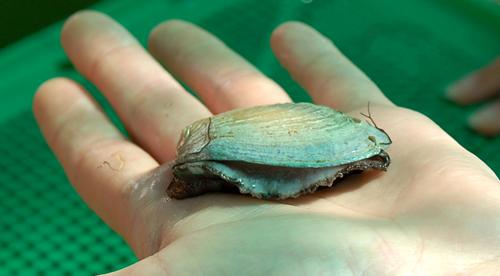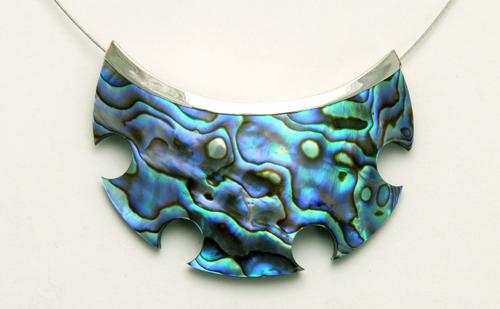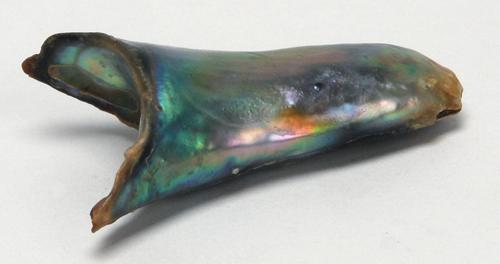Paua shells are the archetypal New Zealand gem – possibly even better known than its nephrite jade, known as ‘greenstone’, or Kauri copal, the fossilised resin or sap of the Kauri Tree. Here, Maggie Campbell Pedersen FGA looks to the ocean to learn more about paua shell, how it is farmed and how it is used in jewellery design.
What are paua?
Paua belong to the large family of molluscs called Haliotidae, of which there are well over 100 species worldwide. Six are found in New Zealand, although only three are common. The most famous and exclusive to New Zealand is the Haliotis iris, known for the beautiful, vibrant colours of the inside surface of the shells. These colours range from striking blues through to aquamarines to greens, with tints of purple and gold. They are influenced by what the animal eats and therefore vary slightly from region to region.
Haliotis are marine gastropods. They carry one shell, and have one large, very muscular foot with which they attach themselves to rocky surfaces (in the case of H. iris the foot has a black outer skin). The name ‘Haliotis’ derives from the Greek, meaning ‘sea ear’, and along one side of the shells are small holes for expelling water in the aeration of the gills. The shell is made up of three layers: a very thin outer layer of conchiolin (a tough, insoluble protein secreted by molluscs, forming the organic matrix of the shell), under which is a chalky-looking rough material and beneath that is the coloured nacre (mother-of-pearl).
In common with other molluscs, the layers of calcium carbonate (in the form of calcite and aragonite) and conchiolin that form their shells, are laid down by the molluscs’ soft bodies. Haliotis, however, lay down the inner layer of aragonite crystals and conchiolin in a slightly haphazard way, stopping altogether if the water temperature does not suit them. This results in areas where the conchiolin becomes very visible, giving an effect of wavy lines of organic material interspersed with beautifully coloured nacre.




A captive-bred, live mollusc ready to be harvested at a farm in Thailand
Where can paua be found?
Pauas live around the rocky coasts of New Zealand and are found at or below the level of the lowest spring tide, that is, at a depth of between one and 12 metres. Much of the paua used for gem purposes are wild-caught, under licence and to extremely strict quota. They can only be fished by free diving – no scuba is permitted – and only a certain number may be fished at any one time, all of which helps to keep the stocks of paua healthy. Furthermore, they may not be fished unless they measure a minimum of 125 mm at the longest part of the shell, which they usually reach at the age of about six years.
When did paua aquafarming start?
Paua aquaculture started in New Zealand in the 1980s. The captive-bred molluscs can be harvested when they are smaller – at about three years old. They are largely used for food, as the shells are not of quite such a vibrant colour. The outer, chalky surface of farmed paua is also pale blue (as opposed to the pale brown of wild paua), due to their feed. The soft bodies of farmed paua are slightly paler, which is considered more attractive as food – indeed the very black surface of the wild paua’s flesh is usually removed before the meat is consumed.
The flesh of the paua is very rich in protein and has been a staple diet of the Maoris, who also used some of the shells in their carvings, almost always to depict eyes. In the large, wooden carvings that adorned Maori ceremonial houses and canoes whole shells were used, and were attached so that the inner, nacreous surface was visible (see below).




How is paua used in jewellery?
The paua shell trade is unusual in that it is found at both ends of the market. It is well known in the form of colourful, whole polished shells, or inexpensive jewellery and trinkets, which are sold as souvenirs in museum shops and other such places. In jewellers’ shops can be found the expensive paua shell items, set in precious metals and with gemstones (see below). At the inexpensive end of the market a little paua shell can go a long way when embedded in moulded clear plastic with a black backing, and is sold in great quantities to the tourist trade. It is made up into various designs, often depicting something specific to New Zealand such as a kiwi bird.


A paua shell necklace by Catherine Best Ltd.
When paua shells are sold whole, the outer, chalky-looking surface is removed to reveal the colourful, nacreous surface beneath, and it takes an expert only about 10 minutes to polish a raw shell on a diamond wheel (see main image). The typical pattern of the nacre with its dark, wavy lines of conchiolin is very attractive, and this is revealed when the outer layers of shell are removed. However, the inside surface of the nacre has a much smoother, almost liquid transition of colours, far fewer lines of conchiolin, and is subsequently considered the better material.
It is from there that the best pieces are taken to make jewellery, and is of course the area in which hemispheres of material are placed to produce blister pearls.
How are paua pearls cultured?
These blister pearls, also known as ‘blue pearls’, first came onto the market around the turn of the millennium.
These round blister pearls, usually referred to as mabés, are mostly produced from wild-caught paua, which are nucleated and treated in much the same way as the oysters in the culture of marine pearls, that is, by suspending them in baskets from lines in areas of clean water and tending them regularly.
The process of inserting the nucleus must be undertaken with utmost care as the smallest incision in the mantle can result in the death of the mollusc – they have no blood-clotting agent and therefore would bleed to death.
Natural paua pearls do exist, but they are always concretions produced by the animal outside the mantle and are inevitably very oddly shaped (see below). The success rate of the pearl production is not high. Only 10% will produce a marketable blister pearl covered with nacre, and only 2% will produce a smooth one of top quality and colour.




A natural paua pearl
Not only must the animals not be injured during the nucleation process, when the mantle is carefully lifted to insert the hemispherical bead underneath, they must then be kept in a stress-free environment for the two to three years it takes to cover the nucleus with nacre and produce a ‘blue pearl’.
As with all organics, science alone cannot ensure success. We also have to rely on the assistance and co-operation of a living creature. ■
The full version of this article originally appeared in Gems&Jewellery July/August 2016 / Volume 25 / No. 4 pp. 10-12
Interested in finding out more about gemmology? Sign-up to one of Gem-A’s courses or workshops.
If you would like to subscribe to Gems&Jewellery and The Journal of Gemmology please visit Membership.
All photos by Maggie Campbell Pedersen, except where otherwise stated
{module Blog Articles Widget}



